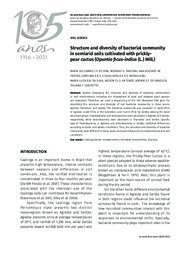Structure and diversity of bacterial community in semiarid soils cultivated with prickly-pear cactus (Opuntia ficus-indica (L.) Mill.).
Structure and diversity of bacterial community in semiarid soils cultivated with prickly-pear cactus (Opuntia ficus-indica (L.) Mill.).
Author(s): LYRA, M. do C. C. P. de; TAKETANI, R. G.; FREITAS, A. D. S. de; SILVA, C. E. R. S. e; MERGULHÃO, A. C. do E. S.; SILVA, M. L. R. B. da; ANTUNES, J. E. L. S.; ARAÚJO, A. S. F. de; GIACHETTO, P. F.
Summary: Abstract: Studies evaluating the structure and diversity of bacterial communities in arid environments including the rhizosphere of local and adapted plant species are important. Therefore, we used a sequencing of the 16S ribosomal RNA gene for describing the structure and diversity of soil bacterial community in three zones: Agreste, Transition and Sertão. The bacterial community was clustered in 9,838 OTUs in Agreste, 8,388 OTUs in the transition, and 14,849 OTUs for Sertão. Among the most abundant phyla, Proteobacteria and Acidobacteria were abundant in Agreste and Sertão, respectively, while Actinobacteria were abundant in Transition and Sertão. Specifi c taxa of Proteobacteria, in Agreste, and Actinobacteria, in Sertão, exhibited differences according to biotic and abiotic conditions. Thus, the structure and diversity of bacterial community were different in these areas and were infl uenced by environmental and soil conditions.
Publication year: 2021
Types of publication: Journal article
Observation
Some of Embrapa's publications are published as ePub files. To read them, use or download one of the following free software options to your computer or mobile device. Android: Google Play Books; IOS: iBooks; Windows and Linux: Calibre.
Access other publications
Access the Agricultural Research Database (BDPA) to consult Embrapa's full library collection and records.
Visit Embrapa Bookstore to purchase books and other publications sold by Embrapa.

